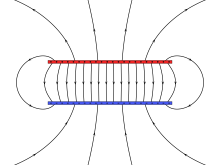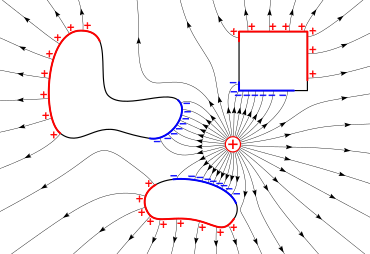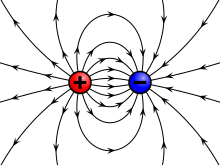Electric field
Jump to navigationJump to search
| Electric field | |
|---|---|

Effects of an electric field. The girl is touching an electrostatic generator, which charges her body with a high voltage. Her hair, which is charged with the same polarity, is repelled by the electric field of her head and stands out from her head.
|
|
|
Common symbols
|
E |
| SI unit | volts per meter (V/m) |
| In SI base units | m⋅kg⋅s−3⋅A−1 |
|
Behaviour under
coord transformation |
vector |
|
Derivations from
other quantities |
F / q |
| Part of a series of articles about |
| Electromagnetism |
|---|
 |
An electric field (sometimes E-field[1]) surrounds an electric charge, and exerts force on other charges in the field, attracting or repelling them.[2][3] Electric fields are created by electric charges, or by time-varying magnetic fields. Electric fields and magnetic fields are both manifestations of the electromagnetic force, one of the four fundamental forces (or interactions) of nature.
Electric fields are important in many areas of physics, and are exploited practically in electrical technology. On an atomic scale, the electric field is responsible for the attractive force between the atomic nucleus and electrons that holds atoms together, and the forces between atoms that cause chemical bonding.
The electric field is defined mathematically as a vector field that associates to each point in space the (electrostatic or Coulomb) force per unit of charge exerted on an infinitesimal positive test charge at rest at that point.[4][5][6] The derived SI units for the electric field are volts per meter (V/m), exactly equivalent to newtons per coulomb (N/C)[7].
Description[edit]

Electric field of a positive point electric charge suspended over an infinite sheet of conducting material. The field is depicted by electric field lines, lines which follow the direction of the electric field in space.
The electric field is defined at each point in space as the force (per unit charge) that would be experienced by a vanishingly small positive test charge if held at that point.[8]:469–70 As the electric field is defined in terms of force, and force is a vector (i.e. having both magnitude and direction), it follows that an electric field is a vector field.[8]:469–70 Vector fields of this form are sometimes referred to as force fields. The electric field acts between two charges similarly to the way the gravitational field acts between two masses, as they both obey an inverse-square law with distance.[9] This is the basis for Coulomb’s law, which states that, for stationary charges, the electric field varies with the source charge and varies inversely with the square of the distance from the source. This means that if the source charge were doubled, the electric field would double, and if you move twice as far away from the source, the field at that point would be only one-quarter its original strength.
The electric field can be visualized with a set of lines whose direction at each point is the same as the field’s, a concept introduced by Michael Faraday,[10] whose term ‘lines of force‘ is still sometimes used. This illustration has the useful property that the field’s strength is proportional to the density of the lines.[11] The field lines are the paths that a point positive charge would follow as it is forced to move within the field, similar to trajectories that masses follow within a gravitational field. Field lines due to stationary charges have several important properties, including always originating from positive charges and terminating at negative charges, they enter all good conductors at right angles, and they never cross or close in on themselves.[8]:479 The field lines are a representative concept; the field actually permeates all the intervening space between the lines. More or fewer lines may be drawn depending on the precision to which it is desired to represent the field.[10] The study of electric fields created by stationary charges is called electrostatics.
Faraday’s law describes the relationship between a time-varying magnetic field and the electric field. One way of stating Faraday’s law is that the curl of the electric field is equal to the negative time derivative of the magnetic field.[12]:327 In the absence of time-varying magnetic field, the electric field is therefore called conservative (i.e. curl-free).[12]:24,90–91 This implies there are two kinds of electric fields: electrostatic fields and fields arising from time-varying magnetic fields.[12]:305–307 While the curl-free nature of the static electric field allows for a simpler treatment using electrostatics, time-varying magnetic fields are generally treated as a component of a unified electromagnetic field. The study of time varying magnetic and electric fields is called electrodynamics.
Mathematical formulation[edit]
Electric fields are caused by electric charges, described by Gauss’s law,[13] and time varying magnetic fields, described by Faraday’s law of induction.[14] Together, these laws are enough to define the behavior of the electric field. However, since the magnetic field is described as a function of electric field, the equations of both fields are coupled and together form Maxwell’s equations that describe both fields as a function of charges and currents.
Electrostatics[edit]
In the special case of a steady state (stationary charges and currents), the Maxwell-Faraday inductive effect disappears. The resulting two equations (Gauss’s law {\displaystyle \nabla \cdot \mathbf {E} ={\frac {\rho }{\varepsilon _{0}}}} and Faraday’s law with no induction term {\displaystyle \nabla \times \mathbf {E} =0}), taken together, are equivalent to Coulomb’s law, which states that a particle with electric charge {\displaystyle q_{1}} at position {\displaystyle {\boldsymbol {x}}_{1}} exerts a force on a particle with charge {\displaystyle q_{0}} at position {\displaystyle {\boldsymbol {x}}_{0}} of:[15]
- {\displaystyle {\boldsymbol {F}}={1 \over 4\pi \varepsilon _{0}}{q_{1}q_{0} \over ({\boldsymbol {x}}_{1}-{\boldsymbol {x}}_{0})^{2}}{\hat {\boldsymbol {r}}}_{1,0}}
- where {\displaystyle {\boldsymbol {r}}_{1,0}} is the unit vector in the direction from point {\displaystyle {\boldsymbol {x}}_{1}} to point {\displaystyle {\boldsymbol {x}}_{0}}, and ε0 is the electric constant (also known as “the absolute permittivity of free space”) with units C2 m−2 N−1
Note that {\displaystyle \varepsilon _{0}}, the vacuum electric permittivity, must be substituted with {\displaystyle \varepsilon }, permittivity, when charges are in non-empty media. When the charges {\displaystyle q_{0}} and {\displaystyle q_{1}} have the same sign this force is positive, directed away from the other charge, indicating the particles repel each other. When the charges have unlike signs the force is negative, indicating the particles attract. To make it easy to calculate the Coulomb force on any charge at position {\displaystyle {\boldsymbol {x}}_{0}} this expression can be divided by {\displaystyle q_{0}} leaving an expression that only depends on the other charge (the source charge)[16][6]
- {\displaystyle {\boldsymbol {E}}({\boldsymbol {x}}_{0})={{\boldsymbol {F}} \over q_{0}}={1 \over 4\pi \varepsilon _{0}}{q_{1} \over ({\boldsymbol {x}}_{1}-{\boldsymbol {x}}_{0})^{2}}{\hat {\boldsymbol {r}}}_{1,0}}
This is the electric field at point {\displaystyle {\boldsymbol {x}}_{0}} due to the point charge {\displaystyle q_{1}}; it is a vector-valued function equal to the Coulomb force per unit charge that a positive point charge would experience at the position {\displaystyle {\boldsymbol {x}}_{0}}. Since this formula gives the electric field magnitude and direction at any point {\displaystyle {\boldsymbol {x}}_{0}} in space (except at the location of the charge itself, {\displaystyle {\boldsymbol {x}}_{1}}, where it becomes infinite) it defines a vector field. From the above formula it can be seen that the electric field due to a point charge is everywhere directed away from the charge if it is positive, and toward the charge if it is negative, and its magnitude decreases with the inverse square of the distance from the charge.
The Coulomb force on a charge of magnitude {\displaystyle q} at any point in space is equal to the product of the charge and the electric field at that point
- {\displaystyle {\boldsymbol {F}}=q{\boldsymbol {E}}}
The units of the electric field in the SI system are newtons per coulomb (N/C), or volts per meter (V/m); in terms of the SI base units they are kg⋅m⋅s−3⋅A−1
Superposition principle[edit]
Due to the linearity of Maxwell’s equations, electric fields satisfy the superposition principle, which states that the total electric field, at a point, due to a collection of charges is equal to the vector sum of the electric fields at that point due to the individual charges.[6] This principle is useful in calculating the field created by multiple point charges. If charges {\displaystyle q_{1},q_{2},…,q_{n}} are stationary in space at {\displaystyle \mathbf {x} _{1},\mathbf {x} _{2},…\mathbf {x} _{n}}, in the absence of currents, the superposition principle says that the resulting field is the sum of fields generated by each particle as described by Coulomb’s law:
- {\displaystyle {\boldsymbol {E}}({\boldsymbol {x}})={\boldsymbol {E}}_{1}({\boldsymbol {x}})+{\boldsymbol {E}}_{2}({\boldsymbol {x}})+{\boldsymbol {E}}_{3}({\boldsymbol {x}})+\cdots ={1 \over 4\pi \varepsilon _{0}}{q_{1} \over ({\boldsymbol {x}}_{1}-{\boldsymbol {x}})^{2}}{\hat {\boldsymbol {r}}}_{1}+{1 \over 4\pi \varepsilon _{0}}{q_{2} \over ({\boldsymbol {x}}_{2}-{\boldsymbol {x}})^{2}}{\hat {\boldsymbol {r}}}_{2}+{1 \over 4\pi \varepsilon _{0}}{q_{3} \over ({\boldsymbol {x}}_{3}-{\boldsymbol {x}})^{2}}{\hat {\boldsymbol {r}}}_{3}+\cdots }
- {\displaystyle {\boldsymbol {E}}({\boldsymbol {x}})={1 \over 4\pi \varepsilon _{0}}\sum _{k=1}^{N}{q_{k} \over ({\boldsymbol {x}}_{k}-{\boldsymbol {x}})^{2}}{\hat {\boldsymbol {r}}}_{k}}
- where {\displaystyle {\boldsymbol {{\hat {r}}_{k}}}} is the unit vector in the direction from point {\displaystyle {\boldsymbol {x}}_{k}} to point {\displaystyle {\boldsymbol {x}}}.
This also allows for the calculation of the electric field due to a continuous distribution of charge {\displaystyle \rho ({\boldsymbol {x}})} (where {\displaystyle \rho } is the charge density in coulombs per cubic meter). Consider the charge {\displaystyle \rho ({\boldsymbol {x}}’)dV} in each small volume of space {\displaystyle dV} at point {\displaystyle {\boldsymbol {x}}’} as a point charge, the resulting electric field, {\displaystyle d{\boldsymbol {E}}({\boldsymbol {x}})}, at point {\displaystyle {\boldsymbol {x}}} can be calculated as
- {\displaystyle d{\boldsymbol {E}}({\boldsymbol {x}})={1 \over 4\pi \varepsilon _{0}}{\rho ({\boldsymbol {x}}’)dV \over ({\boldsymbol {x}}’-{\boldsymbol {x}})^{2}}{\hat {\boldsymbol {r}}}’}
where {\displaystyle {\hat {\boldsymbol {r}}}’} is the unit vector pointing from {\displaystyle {\boldsymbol {x}}’} to {\displaystyle {\boldsymbol {x}}}. The total field is then found by “adding up” the contributions from all the increments of volume by integrating over the volume of the charge distribution {\displaystyle V}:
- {\displaystyle {\boldsymbol {E}}({\boldsymbol {x}})={1 \over 4\pi \varepsilon _{0}}\iiint \limits _{V}\,{\rho ({\boldsymbol {x}}’)dV \over ({\boldsymbol {x}}’-{\boldsymbol {x}})^{2}}{\hat {\boldsymbol {r}}}’}
Electric potential[edit]
If a system is static, such that magnetic fields are not time-varying, then by Faraday’s law, the electric field is curl-free. In this case, one can define an electric potential, that is, a function {\displaystyle \Phi } such that {\displaystyle \mathbf {E} =-\nabla \Phi }.[17] This is analogous to the gravitational potential. The difference between the electric potential at two points in space is called the potential difference (or voltage) between the two points.
In general, however, the electric field cannot be described independently of the magnetic field. Given the magnetic vector potential, A, defined so that {\displaystyle \mathbf {B} =\nabla \times \mathbf {A} }, one can still define an electric potential {\displaystyle \Phi } such that:
- {\displaystyle \mathbf {E} =-\nabla \Phi -{\frac {\partial \mathbf {A} }{\partial t}}}
Where {\displaystyle \nabla \Phi } is the gradient of the electric potential and {\displaystyle {\frac {\partial \mathbf {A} }{\partial t}}} is the partial derivative of A with respect to time.
Faraday’s law of induction can be recovered by taking the curl of that equation [18]
- {\displaystyle \nabla \times \mathbf {E} =-{\frac {\partial (\nabla \times \mathbf {A} )}{\partial t}}=-{\frac {\partial \mathbf {B} }{\partial t}}}
which justifies, a posteriori, the previous form for E.
Continuous vs. discrete charge representation[edit]
The equations of electromagnetism are best described in a continuous description. However, charges are sometimes best described as discrete points; for example, some models may describe electrons as point sources where charge density is infinite on an infinitesimal section of space.
A charge {\displaystyle q} located at {\displaystyle \mathbf {r_{0}} } can be described mathematically as a charge density {\displaystyle \rho (\mathbf {r} )=q\delta (\mathbf {r-r_{0}} )}, where the Dirac delta function (in three dimensions) is used. Conversely, a charge distribution can be approximated by many small point charges.
Electrostatic fields[edit]
Electrostatic fields are electric fields which do not change with time, which happens when charges and currents are stationary. In that case, Coulomb’s law fully describes the field.[19]
Parallels between electrostatic and gravitational fields[edit]
Coulomb’s law, which describes the interaction of electric charges:
- {\displaystyle \mathbf {F} =q\left({\frac {Q}{4\pi \varepsilon _{0}}}{\frac {\mathbf {\hat {r}} }{|\mathbf {r} |^{2}}}\right)=q\mathbf {E} }
is similar to Newton’s law of universal gravitation:
- {\displaystyle \mathbf {F} =m\left(-GM{\frac {\mathbf {\hat {r}} }{|\mathbf {r} |^{2}}}\right)=m\mathbf {g} }
(where {\displaystyle \mathbf {\hat {r}} =\mathbf {\frac {r}{|r|}} }).
This suggests similarities between the electric field E and the gravitational field g, or their associated potentials. Mass is sometimes called “gravitational charge”.[20]
Electrostatic and gravitational forces both are central, conservative and obey an inverse-square law.
Uniform fields[edit]

Illustration of the electric field between two parallel conductive plates of finite size (known as a parallel plate capacitor). In the middle of the plates, far from any edges, the electric field is very nearly uniform.
A uniform field is one in which the electric field is constant at every point. It can be approximated by placing two conducting plates parallel to each other and maintaining a voltage (potential difference) between them; it is only an approximation because of boundary effects (near the edge of the planes, electric field is distorted because the plane does not continue). Assuming infinite planes, the magnitude of the electric field E is:
- {\displaystyle E=-{\frac {\Delta V}{d}}}
where ΔV is the potential difference between the plates and d is the distance separating the plates. The negative sign arises as positive charges repel, so a positive charge will experience a force away from the positively charged plate, in the opposite direction to that in which the voltage increases. In micro- and nano-applications, for instance in relation to semiconductors, a typical magnitude of an electric field is in the order of 106 V⋅m−1, achieved by applying a voltage of the order of 1 volt between conductors spaced 1 µm apart.
Electrodynamic fields[edit]

The electric field (lines with arrows) of a charge (+) induces surface charges (red and blue areas) on metal objects due to electrostatic induction.
Electrodynamic fields are electric fields which do change with time, for instance when charges are in motion. In this case, a magnetic field is produced in accordance with Ampère’s circuital law (with Maxwell’s addition), which, along with Maxwell’s other equations, defines the magnetic field, {\displaystyle \mathbf {B} }, in terms of its curl:
- {\displaystyle \nabla \times \mathbf {B} =\mu _{0}\left(\mathbf {J} +\varepsilon _{0}{\frac {\partial \mathbf {E} }{\partial t}}\right)}
, where {\displaystyle \mathbf {J} } is the current density, {\displaystyle \mu _{0}} is the vacuum permeability, and {\displaystyle \varepsilon _{0}} is the vacuum permittivity.
That is, both electric currents (i.e. charges in uniform motion) and the (partial) time derivative of the electric field directly contributes to the magnetic field. In addition, the Maxwell–Faraday equation states
- {\displaystyle \nabla \times \mathbf {E} =-{\frac {\partial \mathbf {B} }{\partial t}}}
These represent two of Maxwell’s four equations and they intricately link the electric and magnetic fields together, resulting in the electromagnetic field. The equations represent a set of four coupled multi-dimensional partial differential equations which, when solved for a system, describe the combined behavior of the electromagnetic fields. In general, the force experienced by a test charge in an electromagnetic field is given by the Lorentz force law:
- {\displaystyle \mathbf {F} =q\mathbf {E} +q\mathbf {v} \times \mathbf {B} }
Energy in the electric field[edit]
The total energy per unit volume stored by the electromagnetic field is[21]
- {\displaystyle u_{EM}={\frac {\varepsilon }{2}}|\mathbf {E} |^{2}+{\frac {1}{2\mu }}|\mathbf {B} |^{2}}
where ε is the permittivity of the medium in which the field exists, {\displaystyle \mu } its magnetic permeability, and E and B are the electric and magnetic field vectors.
As E and B fields are coupled, it would be misleading to split this expression into “electric” and “magnetic” contributions. However, in the steady-state case, the fields are no longer coupled (see Maxwell’s equations). It makes sense in that case to compute the electrostatic energy per unit volume:
- {\displaystyle u_{ES}={\frac {1}{2}}\varepsilon |\mathbf {E} |^{2}\,,}
The total energy U stored in the electric field in a given volume V is therefore
- {\displaystyle U_{ES}={\frac {1}{2}}\varepsilon \int _{V}|\mathbf {E} |^{2}\,\mathrm {d} V\,,}
The electric displacement field[edit]
Definitive equation of vector fields[edit]
In the presence of matter, it is helpful to extend the notion of the electric field into three vector fields:[22]
- {\displaystyle \mathbf {D} =\varepsilon _{0}\mathbf {E} +\mathbf {P} \!}
where P is the electric polarization – the volume density of electric dipole moments, and D is the electric displacement field. Since E and P are defined separately, this equation can be used to define D. The physical interpretation of D is not as clear as E (effectively the field applied to the material) or P (induced field due to the dipoles in the material), but still serves as a convenient mathematical simplification, since Maxwell’s equations can be simplified in terms of free charges and currents.
Constitutive relation[edit]
The E and D fields are related by the permittivity of the material, ε.[23][22]
For linear, homogeneous, isotropic materials E and D are proportional and constant throughout the region, there is no position dependence: For inhomogeneous materials, there is a position dependence throughout the material:
- {\displaystyle \mathbf {D(r)} =\varepsilon \mathbf {E(r)} }
For anisotropic materials the E and D fields are not parallel, and so E and D are related by the permittivity tensor (a 2nd order tensor field), in component form:
- {\displaystyle D_{i}=\varepsilon _{ij}E_{j}}
For non-linear media, E and D are not proportional. Materials can have varying extents of linearity, homogeneity and isotropy.
See also[edit]
- Classical electromagnetism
- electricity
- History of electromagnetic theory
- Optical field
- Magnetism
- Teltron tube
- Teledeltos, a conductive paper that may be used as a simple analog computer for modelling fields
























































